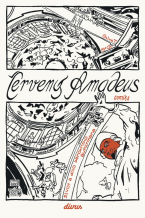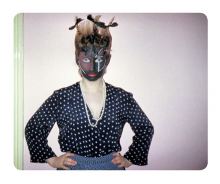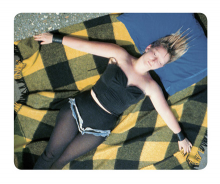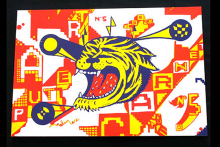| Zeitschrift Umělec 2002/3 >> King Kong and the Palace of the Soviets | Übersicht aller Ausgaben | ||||||||||||
|
|||||||||||||
King Kong and the Palace of the SovietsZeitschrift Umělec 2002/301.03.2002 Susan Buck-Morss | theory | en cs |
|||||||||||||
|
"The movie King Kong opened in New York theaters on 2 March 1933. Two months later on May 5, Moscow announced the winner of the architectural design competition for the Palace of the Soviets. If one compares the drawing of the final variant of the Palace, which incorporated Stalin’s significant modifications, with a widely distributed publicity poster for King Kong (not a still, incidentally, from the film), there is no denying it: In both form and content, the images are strikingly similar.
The original version of the winning Soviet design was a rounded skyscraper topped by a statue of the “liberated proletarian.” The architect, Boris M. Iofan, planned the height of the palace as 220 meters, not much more than half that of the newly constructed Empire State Building (401 meters), at the time the highest building in the world. Five days after the prize was awarded, however, the Palace Construction Council met to consider and approve Stalin’s suggestion that Iofan’s building be larger, and that his “liberated proletarian” be replaced by a gigantic statue of Lenin. The final, revised project of January 1, 1934, was almost double the original size, 420 meters, with a changed shape far closer to that of the Empire State Building and with Lenin’s statue towering 70 meters into the clouds, which would make it the tallest building among modern structures.1 What can be interpreted from the juxtaposition of the images? What does the gigantic statue of Lenin on top of the Palace of the Soviets have to do with the gigantic King Kong, pictured here in his final scene, fending off the bombers that will kill him? King Kong was mass movie entertainment about a captured beast, “a king and god in his own world,” who fought against urban-industrialized civilization and lost. The planned Palace of the Soviets was the proud symbol of proletarian architecture, its image circulating widely and internationtionally in the thirties — while actual construction was delayed and ultimately never took place.2 King Kong, directed by Ernest Schoedsak and Merian Cooper with David Selznick as producer, became the first monster screen classic, a “mastodonic miracle of the movies,” as the studio publicity said, “the strangest adventure drama that this thrill-mad world has ever seen.”3 The Palace of the Soviets, for its part, a monster building, with seating capacity in the great congress hall planned at 21,000, and the goliathsized Lenin statue described as an “assault at the skies.”4 There are faint possibilities of actual connection: the fact that the Palace competition had been going on since 1931 and received continuous publicity outside the Soviet Union;5 the fact that the Empire State Building, completed in 1931 and quickly a symbol of New York City, was also internationally known;6 the fact that Stalin previewed many Western films while preventing their circulation in his country and could well have seen King Kong;7 the fact that one of the (uninvited) entrants to the Palace competition was Hector Hamilton, a New York architect who had visited the Soviet Union as part of a team that, according to a Soviet newspaper report, was building “a radio-city in New York” (where King Kong would have its premier), and saw the preliminary Palace projects, admiring their amazing scale.8 But even if the U.S. filmmakers knew about the Palace competition, the movie predated the announcement of the winner. And if Stalin had seen the movie, he would have had little motivation to place Lenin in the compromising position of the defeated beast King Kong. It is likely that both the Palace designers and the moviemakers were influenced by another source, for which there were several possibilities. The idea of integrating monumental human figures into modern architectural forms was characteristic of several entries to the Palace competition.9 Consider, as well, Malevich’s architectons, which were on display in 1932 at the Leningrad exhibition Artists of the RSFSR During Fifteen Years of Soviet Rule.10 The center model, tallest in size, is topped by a statue presumably of Lenin.11 However obscure the prehistory of these images, their afterhistory has been assured. The Palace of the Soviets has become the quintessential example of Stalinist monumentality, an icon of the architecture of dictatorship, while King Kong is the campy ur-form of a whole genre of science fiction films, from Godzilla to Jurassic Park. Can they, as dream images, be made to speak to each other, circumscribing two complementary economies of desire? Lenin has in common with King Kong the fact that both are symbols of the masses, displayed as spectacles for the masses. Like all dream images their meaning is ambivalent, vacillating between a desire that is expressed and a fear that holds it in check. This is what gives them their power to thrill. It is through seduction that they exert control. King Kong is a movie about making a movie. A New York director has a map of an uncharted island and wants to sail there to film its mystery, which turns out to be the monster, King Kong. He finds a girl, Ann, on the New York streets stealing apples — it is the time of the Great Depression — and promises to make her a star. When the hero, who will later fall in love with Ann, asks: “Why take a girl along?” The director responds: “Because the public, bless ‘em, has to have a pretty face to look at… and this time I’m going to give ‘em what they want.” Of course, the public is not alone. The movie opens with an “old Arabic proverb”: “And lo, the beast looked upon the face of beauty.” It proves his undoing, at least according to the director, who proclaims over Kong’s fallen, furry body lying dead at the base of the Empire State Building: “It was beauty that killed the beast.” Because Kong, too, falls in love with Ann, he is identified with the public that “loves a pretty face,” precisely the mass audiences whom the director in the film and the directors of the film hope to attract.12 Descriptions of the masses as a giant animal, an instinctual, primitive force, were common at the time,13 an association in the film that intensifies when the director and his movie crew reach the mysterious Skull Island. King Kong is held back behind a giant gate from natives who have forgotten the more advanced civilization that built it. The native “primitives” worship Kong, providing for him the obligatory sacrifice of virgin girls. There is much in the movie that is racist. The dark-skinned villagers are as far removed from civilization as Kong himself.14 But the film’s depiction of the “barbaric” and “primitive” have an antidemocratic association as well. When the natives, planning to kidnap the blond heroine as a sacrifice for Kong, carry torches through the village and sing primitive chants, the director quips, watching from the ship, “It looks like the night before election.” The jungle into which Kong abducts Ann is a surreal space where prehistory, populated by dinosaurs, has all of the dreamlike quality of unconscious forces. We are clearly in the realm of sexual fantasy; the prehistoric beasts are raw, virile power, and Ann’s abduction by Kong is a seduction as well.15 Yet the connection between beasts and dangerously powerful masses (the working class during the depression) is sustained in the staging of a boxing match between Kong and a dinosaur that mirrors the cuts and jabs of this quintessentially working-class sport.16 Kong is massive, “as big as a house.” When he is brought back captive to “civilized” New York, this colossal, bestial force rebels, tearing apart his chains like some revolutionary proletariat that has just read the Communist Manifesto, and terrifying the well-dressed audience whom he has been placed on the stage to entertain. Loose on New York’s streets, Kong destroys the elevated train like a mob on the rampage. (“It’s a kind of Gorilla!” someone says. “Gee, ain’t we got enough of them in New York?”) Enraged at “civilization,” Kong has the brute strength to threaten structures of power. But lured by the spectacle of a pretty face, his subjectivity changes from threatening to loving in a prototypical example of the “metamorphosis of consumption.”17 Diverted by the display of fashionable female beauty, he succumbs, not only to love but to the bourgeois proprietary impulse, the desire for possession. Holding Ann tenderly in his paw like a child’s toy, Kong plucks off pieces of her pretty dress like petals. Or he grabs her out of a skyscraper window, as if out of a shop window, and carries her off. The director, making a direct analogy to Kong, observes that even “tough guys,” go “soft and sappy” if “beauty gets to” them, suggesting a vitiation of virility connected with consumption and implying a “feminine” side to the masses symbolized by Kong. But it is a dangerous femininity, irrational, primitive, and out of control. King Kong is no Frankenstein produced by the latest in technology but rather an atavistic residue from a past era, a return of the repressed. The audience in the film is terrified by the unleashed monster. The audiences watching the film (we ourselves) feel not only terror but empathy as well. He embodies the force of our own desire to find in a romantic dreamworld solace for the industrial civilization that brutalizes the physical animals all of us remain. King Kong was escapist entertainment for a public in the throes of the Great Depression, channeling antisocial forces into romance and adventure while showing the animal symbol of the crowd as defeated definitively. The circuit of desire, like that of the commodity, is acted out in the space between the cultural object (the film) and collective imagination, a space of leisure cordoned off from the production process. And it is important that, although the audience of King Kong sees the story of the movie’s movie in the making, they do not see how the real movie was fabricated. Of course, Kong’s prehistoric world was a modern technological accomplishment. But to this day, how some of the film’s special effects were achieved remains a mystery. In the movie the director says to the crowd of well-heeled people who have paid twenty dollars to be entertained by Kong: “Seeing is believing.” But what cannot be seen remains misunderstood. The fact that the means of production of a cultural commodity is invisible is the trademark of capitalist spectacles. They are phantasmagorias that seduce the senses, a shadowland of the fulfillment of desire. One last point, a bizarre detail. The directors of King Kong — the real directors, Cooper and Shoedsack — make a brief appearance within the film. They are the fighter team in one of the U.S. Air Force planes that shoot down Kong. (It is, indeed, not beauty that kills the beast, but the technologically armed power of the state.) Cooper is reported to have had the idea of this cameo appearance: “We should kill the sonofabitch ourselves.” He had learned to fly in World War I. After the war he stayed in Europe as a mercenary pilot, hired in 1920 to fight on the side of Poland in the war against Bolsheviks.18 Notes: 1. For a detailed description of the competition, see Karl Schlögel, “The Shadow of an Imaginary Tower,” in the exhibition catalogue Naum Gabo and the Competition for the Palace of Soviets, Moscow, 1931–1933 (Berlin: Berlinische Galerie, 1992). 2. See above, section 2.2, fragment titled “Reverse Motion.” 3. J. H. Matthews, Surrealism and American Feature Films (Boston: Twayne Publishers, 1979), p. 62. 4. Schlögel, “ The Shadow of an Imaginary Tower,” pp. 179–180. 5. In 1931 the competition was announced as finally bringing to fruition the earlier proposal of the First Congress of Soviets (1922) for a building to be erected in Moscow, a “Palace of Labor,” that would serve for meetings of the Soviets of the Union. Because this meant building auditoriums for 15,000 and 8,000 people, the scale was necessarily huge. The publicity stated: “Only now, though, with the great successes of socialist construction achieved and the First Five-Year Plan completed in four years… are all preconditions fulfilled for realizing the First Congress’s decision.” Cited in Catherine Cooke, “Mediating Creativity and Politics: Sixty Years of Architectural Competitions in Russia,” in The Great Utopia: The Russian and Soviet Avant-Garde, 1914–1932 (New York: Guggenheim Museum, 1992), p. 707. 6. A model of the Empire State Building was shown in 1931 at the American pavilion at the International Colonial Exhibition in Paris. By the end of the twentieth century it had appeared in approximately ninety movies, of which King Kong remained the most famous: “Just as the building was billed as ‘The Eighth Wonder of the World,’ so was the movie’s tragic hero” (John Tauranac, The Empire State Building: The Making of a Landmark [New York: Scribner, 1995], pp. 24–25. 7. “Stalin lavished extraordinary amount of attention on cinema. From the mid-1930s to the end of his days he was the chief censor. He personally viewed and approved every film exhibited in the Soviet Union.” Peter Kenez, “Soviet Cinema in the Age of Stalin,” in Richard Taylor and Derek Spring, eds., Stalin and Soviet Cinema (New York: Routledge, 1993), pp. 62–63. See also above, chapter 4, note 51. 8. A contemporary (1931) Soviet journal, cited in Cooke, “Mediating Creativity and Politics,” p. 707. See ibid., p. 698, for sketches of Hamilton’s entry for the Palace competition, which resembles Iofan’s original contribution more than it does the final variant, modified by Stalin. The visiting team referred to in the newspaper report must have been the same in which “Roxy” Roth participated, who was impressed my Melnikov’s SONaia SONata as a model for Radio City Music Hall (see above, section 3.2). 9. See Melnikov’s fantastic entry, which, in putting proletarians on top of an inverted pyramid, could be read as a criticism of the growing bureaucracy (S. Frederick Starr, Melnikov: Solo Architecture in a Mass Society [Princenton: Princeton University Press, 1978], pp. 157–161). 10. Malevich’s architectons date to the Leningrad UNOVIS period in the mid-1920s. In the Leningrad exhibition of 1932, Malevich was given a whole room to set up his work, with the help of Suetin. In June 1933 this show opened in Moscow in a changed cultural climate, and the “objectless” artworks of Malevich (along with those of Tatlin, Filonov, Popova, and Altman) were relegated into one crowded room; a reviewer referred to their work as a “serious tragedy”: “they elicited such a centrifugal force in their art that it carried them out of art to the beyond to nowhere, to non-existence” (cited in Charlotte Douglas, Kazimir Malevich [New York: Harry N. Abrams, 1994], p. 24). 11. It is possible that this statue was not meant seriously by Malevich but was intended, rather, to mislead the authorities: “An assistant to Malevich, R. Pavlov, recalls that a common plaster figure of Lenin, that had been bought in an ordinary stationery store, was placed on the architecton. When the committee left, the statuette was laughingly taken down and put away until the next unpleasant visit” (Vasilii Rakitin, “The Advant-Garde and Art of the Stalinist Era,” in Hans Günther, ed., The Culture of the Stalin Period [New York: St. Martins’ Press, 19909], p. 184). 12. The 6,200-seat Radio City Music Hall where King Kong opened in New York was advertised as “the world’s largest picture house”: the Giant, the largest theater in Leningrad, built in 1927–1928, seated only 1,000 people. 13. In 1930, for example, Ortega y Gasset described the politically aroused masses as “the primitive in revolt, that is, barbarism” (José Ortega y Gasset, The Revolt of the Masses, trans. Anonymous [New York: W. W. Norton, 1932], p. 98). 14. When the Chinese cook on board the ship is reprimanded for wanting to join the struggle — “This is no job for a cook” — the racism takes on a political tone of anti-immigrationism. 15. The discrepancy in their size makes them “a remarkably incongruous bridal couple,” but the erotic element is there nonetheless (Matthews, Surrealism and American Feature Films, p. 72). 16. “While working on the fight sequences involving Kong and the tyrannosaurs, the movie’s chief technician, Willis H. O’Brien, and his first assistant, E. B. Gibson regularly attended boxing and wrestling matches” (ibid., p. 70). 17. The phrase is from Stuart Ewen and Elizabeth Ewen, Channels of Desire: Mass Images and the Shaping of American Consciousness (New York: McGraw-Hill, 1982). 18. Matthews, Surrealism and American Feature Films, p. 77. From chapter 5 of Dreamworld and Catastrophe by Susan Buck-Morss, used with the permission of the publisher MIT Press "
01.03.2002
Empfohlene Artikel
|
|||||||||||||
|
04.02.2020 10:17
Letošní 50. ročník Art Basel přilákal celkem 93 000 návštěvníků a sběratelů z 80 zemí světa. 290 prémiových galerií představilo umělecká díla od počátku 20. století až po současnost. Hlavní sektor přehlídky, tradičně v prvním patře výstavního prostoru, představil 232 předních galerií z celého světa nabízející umění nejvyšší kvality. Veletrh ukázal vzestupný trend prodeje prostřednictvím galerií jak soukromým sbírkám, tak i institucím. Kromě hlavního veletrhu stály za návštěvu i ty přidružené: Volta, Liste a Photo Basel, k tomu doprovodné programy a výstavy v místních institucích, které kvalitou daleko přesahují hranice města tj. Kunsthalle Basel, Kunstmuseum, Tinguely muzeum nebo Fondation Beyeler.
|



































 New book by I.M.Jirous in English at our online bookshop.
New book by I.M.Jirous in English at our online bookshop.
Kommentar
Der Artikel ist bisher nicht kommentiert wordenNeuen Kommentar einfügen